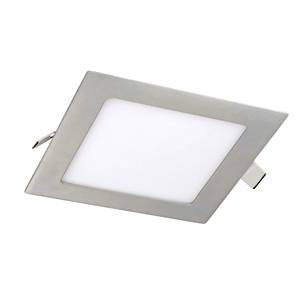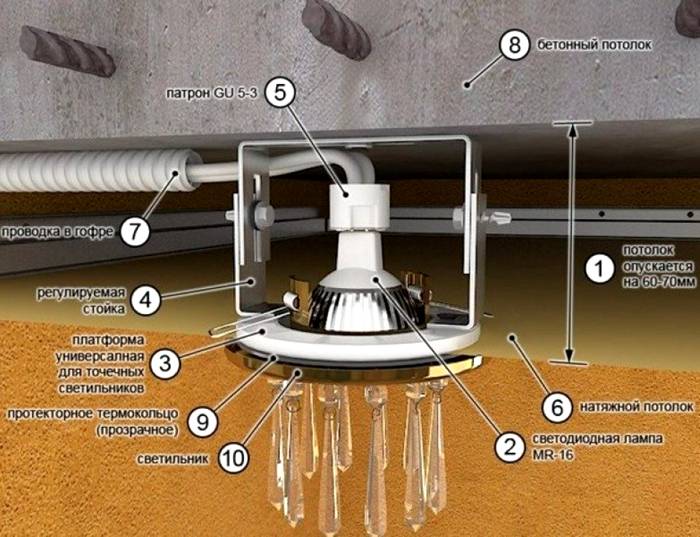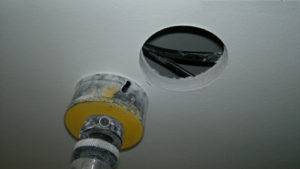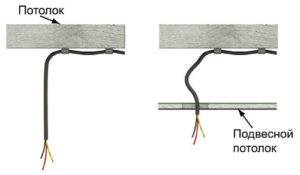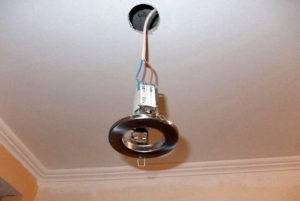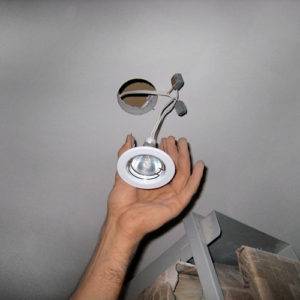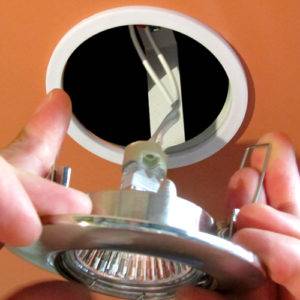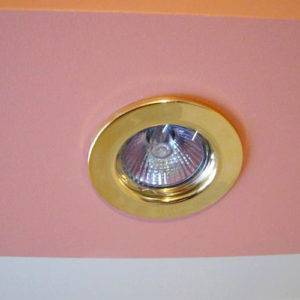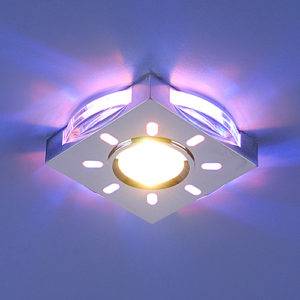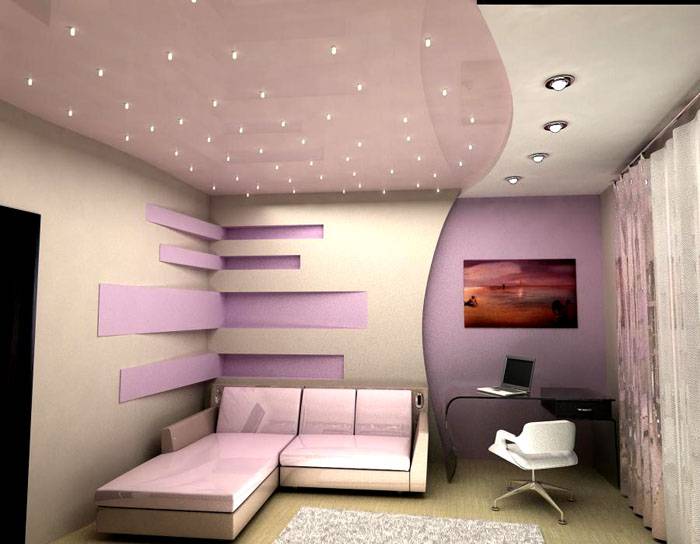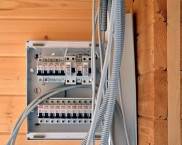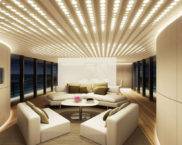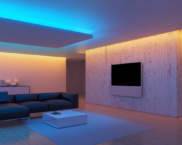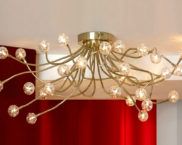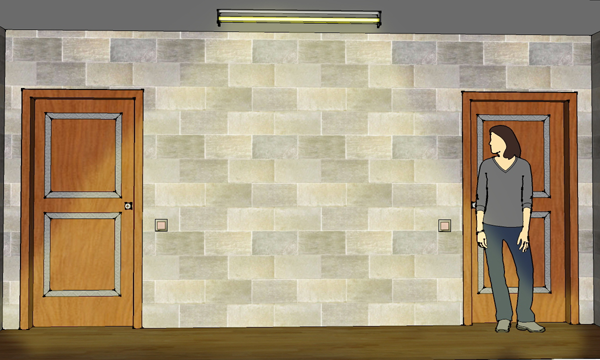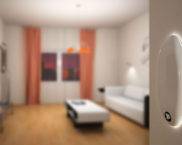Selection and installation of spotlights on plasterboard ceilings
Indoor light sources have always been an important component. The right choice and location allows you to turn the top coat into a spectacular work of art. Once the room was lit alone chandelier, today spotlights for plasterboard ceilings can be placed anywhere in the ceiling. The easy installation of this lighting equipment and the suspended ceiling system allows the installation of all electrical and structural components in the ceiling span. This allows you to form both background lighting and local area lighting.
The content of the article
- 1 Spotlights for plasterboard ceilings: types and differences
- 2 Recessed LED ceiling spotlights: model overview, photo and price
- 3 Installation of spotlights in a plasterboard ceiling
- 4 Tips for installing ceiling lights embedded in plasterboard structures
- 5 Video: installation and connection of spotlights
- 6 Conclusion
Spotlights for plasterboard ceilings: types and differences
Point directional lighting elements are divided into types:
- by design;
- by lamps;
- by the consumed voltage;
- by the method of installation.
The overall lighting scheme depends on these categories. It is harmonious and room design, and the economic feasibility of using a particular incandescent lamp, and compliance with certain safety rules. It is advisable to have an idea of the performance characteristics of each light source before drawing up a lighting installation plan.
The structure of spotlights
The point-type lighting element consists of a body, a base, a protective cover and two spring-loaded retaining brackets. Most often, the luminaire body is made of inexpensive plastic. But there are also light sources made of strong thermoplastic, with a glass or metal body. The service life of such devices is longer. To give a beautiful look, the outer component is chrome plated, polished with brass, covered with bronze and gold.
The design of spotlights for plasterboard ceilings is divided into the following types:
- embedded - characterized by the fact that the luminaire body is invisible and is located in the span between the ceiling and drywall, outside there is only a decorative edging and a socket for a light bulb;
- waybills - the body of the lighting fixture is visible and installed directly to the ceiling structure, has different dimensions and design shapes;
- swivel - the luminaire body has a rotary mechanism, due to which it is possible to change the direction of illumination, it is advisable to use it for highlighting a certain area;
- irrevocable - the device body is firmly fixed to the lighting area and does not have the ability to redirect the luminous flux to another area of the room;
- single - differs in equipment from one cartridge and one light bulb;
- blocky - lighting element from several lampsmounted in a common decorative body.
The range of sizes for plasterboard spotlights is wide enough. There are luminaires on the market with a bore from 30 mm to 200 mm. Such a variety of lighting elements allows you to choose the right option to illuminate the required space.
Types of lighting devices by type of lamp
Lamps of the point type, which are intended for installation in sheet finishing material on the ceiling, can be connected to lamps:
- incandescent;
- LED;
- halogen;
- luminescent.
Each of them has its own characteristics that must be taken into account when developing a lighting system. They differ in price and power consumption.
Incandescent lamps are considered budgetary. When installing a lighting system with these elements, there is no need to purchase other equipment, you just need to stretch the wiring.
But, despite the ease of installation, ordinary bulbs have a number of disadvantages:
- overall dimensions affecting the interceiling space: at a standard ceiling level (250 cm), the distance between the suspended structure and the floor slab should be at least 20 cm (taking into account the cartridge and the height of the light bulb itself), and this will significantly reduce the ceiling level;
- strong heating of the light bulb during operation: this leads to deformation of the plastic housing of the lamp, and at high power of the lighting element, additional fire safety measures are required;
- uneconomical use: short service life and high energy consumption.
LED bulbs are more acceptable for use. They consume a small amount of electricity, there is a choice of colors, and their service life is quite long. In homes, the warm shades of LED spotlights are more pleasing to the eye. For plasterboard ceilings light sources with a cool color are suitable for office premises.
Advice! If you connect additional equipment to the lighting system - a dimmer, you can adjust the brightness of the luminous flux. With its help, it is very easy to create both diffused light and saturated light in the room.
The height of LED lamps allows using the height of the pendant structure at the level of 5-6 cm. LED lighting is expensive from the financial point of view, but it is fully compensated for by energy savings.
Halogen bulbs are also popular for creating good lighting. They are able to create a powerful directed stream of light, which diffuses a special shade. They are advantageous in the price range and in the consumption of electricity. The dimensions of the halogen lamps make it possible to mount the luminaires into the ceiling span at a distance of 5 cm.
Among the disadvantages is the need for additional equipment:
- dimmer - to adjust the light;
- transformer, capable of supplying a comfortable voltage of 12V.
Distinctive features of fluorescent lamps are high luminescence saturation and long service life. They are considered energy efficient, but not without disadvantages:
- they require special disposal;
- light is not very favorable for perception;
- high plinth, which does not allow creating a minimum ceiling space.
Differences in voltage parameters
Lighting manufacturers offer the following types of luminaires that require different voltage supply:
- lighting sources dependent on 220 V;
- devices designed to supply 12 V;
- LED luminaires requiring 3 V.
The supplied voltage depends entirely on the category of the lamp, therefore, before installing the lighting system, it is necessary to provide for the type of lighting elements. For example, to lower the voltage, you will need a transformer, and to install LED devices, a device driver... If the type of luminaires is changed electrical wiring will have to change.
Protection against external influences
This parameter characterizes the degree of protection of the device against environmental influences. It also affects where it is mounted. Spotlights for open-type plasterboard ceilings are in contact with the external environment and can only be used in ordinary places. In structures of this type, a protective cover is not provided, therefore, in spaces with high humidity, they will quickly fail and may even cause an accident.
The characteristics of closed-type luminaires are directly opposite to the previous description, therefore they are intended for use in baths, saunas, bathrooms.
According to the IP index classification, the degree of security is determined by two indicators. The first index characterizes the level of protection against small particles, the second against moisture. The gradation of indicators starts from a complete lack of protection and ends with guaranteed protection.
Related article:
LED ceiling lights for home ideal for multi-level ceilings. Let's find out what they are and how to use them more profitably.
Recessed LED ceiling spotlights: model overview, photo and price
If you need good quality fixtures for installation in a plasterboard ceiling, then you should pay attention to the manufacturer of the products. Famous brands Novotech, Arte Lamp, Light star, Favorite Flashled offer lighting products in different shapes and colors. In addition to imported brands, you can buy locally produced spotlights.
Table 1. Overview of LED spotlights recessed into the ceiling: photo and price
Installation of spotlights in a plasterboard ceiling
Installation of such lamps in dry plaster ceiling sheets does not require special skills. The main thing is to lay the wiring, correctly mark the holes, and then drill them. The installation process itself will take a little time.
Necessary materials
For work you will need:
- stranded copper electrical cable with a cross section of 1.5 mm2;
- terminal blocks for connecting pieces of wire;
- corrugated pipe for placing a cable in it;
- copper sleeves for crimping twists (if necessary);
- for a lighting system made of halogen lamps - a transformer;
- for lighting from LED lamps - current driver.
Advice! It is important to remember that if, during a serial connection, one device burns out, then the entire lighting system turns off. When connected in parallel, you will need several drivers, and for each lighting device.
Tools used
To perform a high-quality installation of ceiling devices, you need tools:
- roulette;
- crimping pliers;
- voltage phase indicator;
- an electric drill with a core drill for drilling holes;
- set of screwdrivers;
- wire cutters;
- wire stripper.
Mounting
To obtain a uniform glow, it is necessary to install lamps in a plasterboard ceiling with strict adherence to certain rules:
- the gap between the wall and the lamp is 60 cm (55 cm is possible);
- the distance between the lighting points is not more than 1 m;
- the interval between lighting devices in one row is no more than 1.5 m.
Important! When installing an overhead spotlight on the ceiling, you will need an installation site. It is rigidly attached to the ceiling and located under the plasterboard. It is to her that the overhead device will be mounted.
The preliminary stage of installation of lighting elements (marking of the locations of the lamas and wiring of the cable) is carried out before the installation of the plasterboard floor. As soon as the ceiling is ready, you can start installing lighting devices.
Table 2. Installation of lighting devices
Related article:
LED Ceiling Lights for Stretch Ceilings, hanging and others, serve as an excellent alternative. This is unusual and somewhat new, so it is worth getting to know such lighting devices in the article closer.
Tips for installing ceiling lights embedded in plasterboard structures
When installing point devices in a plasterboard ceiling, it should be understood that:
- the process of organizing lighting and technological innovations are not intricate, therefore, any craftsman who has at least some knowledge of electrical engineering and construction can cope with installation in a suspended structure;
- a bold design solution in the arrangement of the interior and the use of modern lighting schemes will effectively affect the result of creating comfort;
- the result of the work done is the safety of the premises and the exclusion of the threat of danger to the people living in it.
Video: installation and connection of spotlights
Conclusion
The organization of lighting in suspended structures is not very difficult. This work can be carried out on your own, but at the same time you should remember about the interval of the location of the lamps and the use of medium-power bulbs.The best choice for plasterboard ceilings are LED spotlights. They heat up slightly and cannot damage the lighting system.




















